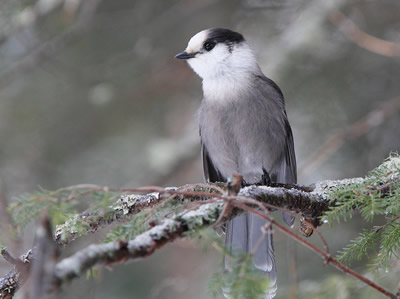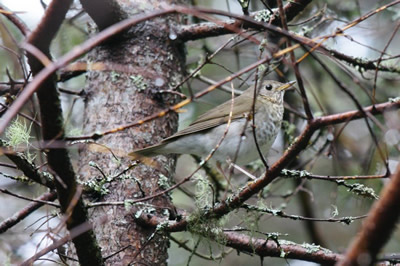Finding Bicknell’s Thrush and Boreal Specialties in New Hampshire

Classic boreal species (Gray Jay, Boreal Chickadee, Black-backed Woodpecker, and Spruce Grouse) are found in spruce-fir habitat and may be seen in the Lake Umbagog area. They can sometimes be found along the Magalloway River while canoeing out to the lake or in the area between Route 26 and the western shore of the lake. A drive along the 13 Mile Woods on Route 16 south from Errol may turn up nesting Black-backed Woodpeckers and occasional sightings of the other three boreal species.
Outside of the Lake Umbagog area, the Pittsburg area and the higher elevations of the White Mountain National Forest are your best bets for finding these species. In Pittsburg, check the East Inlet and Scott Bog area as well as Moose Falls and Deer Mountain (including the Deer Mountain Campground on Rt. 3).
In the White Mountains, any spruce-fir habitat has potential for boreal species, particularly areas above 3,000 feet. A drive along the Jefferson Notch Road and a stop at the Caps Ridge trailhead may produce all four species. Spruce Grouse are regularly reported in the Mizpah Springs hut area near Mount Jackson and Mount Webster. This area contains excellent habitat for the other three species and makes a nice hiking loop for those in good shape. Mount Willard in Crawford Notch is an easy trail with good potential for Boreal Chickadees and Gray Jays.

Bicknell’s Thrush is a highly sought-after bird of the high elevation spruce-first. There are two popular places to look and listen for Bicknell’s Thrush that do not require a hike. One is the Mt. Washington Auto Road from the Half-Way House or higher and the other is the top of Cannon Mountain which can be reached by a tram (for a fee). In addition, you can listen for Bicknell’s Thrush at the overlook rocks about a mile up the Caps Ridge trail (mentioned above) towards Mount Jefferson or on any high elevation hike in the Presidential peaks of the White Mountains.
Spruce-fir areas in the White Mountains are also good for finding Blackpoll Warblers and Yellow-bellied Flycatchers. Any hike in the White Mountains requires a good map and adequate preparation for the trail difficulty and weather conditions. Even in the summer, a hike to high elevation can be dangerous because the weather can change quickly and unexpectedly. Consult one of the local visitor centers for more information.
If you can’t hike, try one of the ski areas (such as Cannon Mountain or Wildcat Mountain) that offer summer rides to the summits. For information on hiking trails, check the AMC White Mountain Guide. Detailed road maps can be found in the DeLorme New Hampshire Atlas and Gazetteer.
Click here to access the free New Hampshire Bird Records article “Birding in the White Mountains in June and July” by Mark Suomala.
These are only a few ideas of places to find boreal species. Keep your eye out for them in any spruce-fir habitat. Good luck!